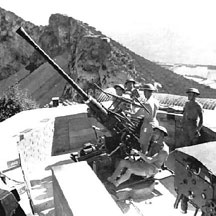| The
Rock of Gibraltar:
Fact or Fiction?
By Kevin Canada
June 2013
The name Gibraltar has been synonymous with
"invincible" for centuries. Its
forbidding presence at the southern tip of
Spain long served as a material reminder of
Great Britain's dominance over the Western
Mediterranean and Eastern Atlantic. During
World War II this image was reinforced by
clever propaganda as well as material improvements.
War posters showing the bristling batteries
of Gibraltar, prepared to defend against all
comers, graphically underscored the popular
ideal of the fortress. Modern books such as
Das Boot illustrated the very real
dangers posed by Gibraltar-based anti-submarine
warfare units to German U-Boat commanders.
Wargamers have also indulged in perpetuating
the ideal of "The Rock," frequently
portraying it as a huge fortress, comparable
to the Maginot Line in its complexity. In
naval simulations it�s often a literal
cork on the west end of the Mediterranean,
preventing Italian surface sorties into the
Atlantic, or German warships from entering
the Mediterranean.
Considering the repeated failures of other
famous fortresses across the globe, there
is some cause for wondering just how "invincible"
the Rock of Gibraltar really was, and just
how capable it would have been in stopping
a modern siege or a move by an enemy fleet
to bypass it.
The Pillar of Hercules
Physically, Gibraltar is a limestone mountain
rising some 426 meters from sea level, dominating
the Straits of Gibraltar, which are less than
16 miles across to Spanish Morocco. The entire
territory is less than a kilometer wide and
five kilometers long. Along its western side
is Gibraltar Bay, where the Port of Gibraltar
is located, with a breakwater and facilities
almost 50% as large as the territory itself.
The mountain itself is honeycombed with 34
miles of tunnels dug into the rock by the
British over the years, providing cover for
numerous gun emplacements, hangars, storage
facilities, barracks, hospitals and thousands
of troops.
Militarily, the fortress was used primarily
as a naval base and air station, since its
limited size allowed it to support a garrison
of only 15,000 ground troops. The one airfield,
running across the length of the peninsula
at the northern extreme of the territory,
was expanded into Gibraltar Bay starting in
1937 and completed by 1942. This allowed support
for nearly 100 fighters and several squadrons
of medium and heavy bombers, and allowed Gibraltar
to act as a vital staging point for aircraft
transferring into the Mediterranean theater.
Anti-air defenses were substantially improved
during the war. In 1940, there were some 20
3.7" guns, four 4" guns, 10 40-mm
Bofors and two pom-poms, plus numerous searchlights.
1942, this complement had been increased to
30 3.7" guns and almost 20 Bofors.
The naval base at Gibraltar had been built
before World War I as a response to German
pretensions toward becoming a naval power.
By 1939 it was one of the most important British
naval facilities outside the home islands,
providing a relatively secure anchorage and
repair facility for the British Navy. This
was the home port for Somerville's Force H,
which gave the British Navy an extraordinary
ability to project its power into the Western
Mediterranean and successfully contest the
Italian Navy's attempts to control the sea.
| 
Making the Rock a hard place: British
anti-aircraft gunners.
|
The seaward defenses of the fortress were
quite varied but, while formidable, not quite
the propaganda image of the Rock, bristling
with guns. The primary batteries were a set
of twin 9.2" naval guns guns at the southern
end of the peninsula, which had sufficient
range to interdict all surface naval traffic
through the straits. Six more single-gun batteries
of 9.2" naval guns were placed facing
seaward to the east. Finally, a twin 9.2"
howitzer battery faced the straits as well.
The secondary batteries were just as numerous,
with eight 6" naval guns, although three
of these faced northward, toward the border
with Spain. A tertiary armament of four 4"
guns in two batteries protected the eastward
cliffs.
�Conquerable by No
Enemy�
Despite these formidable assets, the Allies
themselves considered the fortress highly
vulnerable. They expected that any concerted
Axis assault would cause the fall of the position
in at best two weeks, at worst a few days.
Indeed, prior to the Operation Torch landings
in North Africa in late 1942, the Allies worried
that the Spanish garrison bordering Gibraltar
� about 33,000 troops � could
quickly be augmented by 20,000 German military
personnel covertly placed inside Spain in
anticipation of an attack on the fortress
(some estimates placed this as high as 80,000).
Allied planners greatly feared a Crete-style
air assault, especially in conjunction with
a determined ground assault.
Gibraltar was extremely exposed to artillery
and air bombardment, with three major Spanish
artillery batteries (one in North Africa at
Mount Hacho, two near Algiceras � only
five miles away from the port) positioned
to blast the "Rock" into rubble,
collapsing its tunnels and destroying its
exposed heavy batteries, as the Japanese had
done at Corregidor in 1942. Incidentally,
one critical asset, water, was only available
from collected rain water runoff, as there
was no other natural source of potable water
on the Rock itself.
Throughout the war, Italian airmen bombed
Gibraltar with mixed success. Moreover, the
all-important airfield was only a few hundred
yards from the border with Spain, which left
it extremely vulnerable to bombardment from
Spanish-controlled positions, which could
give the Axis control of the air until sufficient
Allied aircraft carrier sources might (eventually)
be brought to bear. Finally, while the port
itself was very well protected, the bay �
used as an anchorage for merchant shipping
throughout the war � was infiltrated
on numerous occasions by Italian frogmen operating
from the battered Italian freighter Olterra
docked on the Spanish side of the bay, successfully
sinking some 42,000 tons over two years.
Given this apparent vulnerability, one wonders
about the "invincible" status traditionally
conferred on Gibraltar by historians and wargamers
alike. The rather light gun batteries placed
on the fortress do not appear to have been
much of a threat to battleships. Even heavy
cruisers would more than likely have been
able to pass under Gibraltar's guns with only
light damage, at worst.
In part the myth seems to have been perpetuated
by the simple fact that using naval assets
to bypass the "Rock" was apparently
never seriously considered by Germany or Italy
during the war. Certainly the Italians had
no strategic reason for deploying their scant
battlefleet (short on fuel, as always) beyond
the Mediterranean � such an act would
have been an unacceptable concession of sea
control to the British, and ended definitively
any pretensions of an Italian Empire in Africa
for Il Duce.
Likewise, the Germans would never have committed
elements of their even smaller surface fleet
to be potentially trapped in the Mediterranean.
Had the Axis had greater forces at their disposal
� say, through the successful seizure
of the French battlecruisers Dunkerque
and Strasbourg � there
might have been a reason for a deployment
from the Mediterranean to the Atlantic.

When looked at broadly, the greatest strength
of Gibraltar was from its strategic position
at the western mouth of the Mediterranean,
and the well-developed naval and air facilities
which the fortress protected. These combined
attributes, rather than any physical "punch"
from the fortifications themselves, provided
the real deterrent. The narrowness of the
straits contributed significantly to Gibraltar's
strength, since there was little room for
an opponent to avoid air or naval forces that
could be easily concentrated to confront an
intruder. The difficulties encountered by
even German submarine forces attests to the
risk of running past a station where strong
ASW units are very near their base.
Throughout the war, Britain garrisoned Gibraltar
with many of its most important naval assets:
The Rodney, Hood, Ark Royal
and Renown were variously stationed
there. Most of the critical Malta resupply/reprovision
convoys started from Gibraltar, and were able
to enjoy the cover of its air umbrella for
the first third of the journey. By late in
the war, Allied air-based ASW patrols extended
almost to the Azores, and severely curtailed
Donitz's ability to threaten Allied shipping
after 1943.
The images of Gibraltar in history, propaganda
and wargames as an invincible fortress are
thus probably overblown. It makes sense, for
example, to allow an Axis naval unit to pass
by Gibraltar unimpeded in a game like Third
Reich should the Allies fail to sufficiently
garrison it with air and naval units to block
the enemy's way. Conversely, it makes no sense
to allow an Allied player to stack whole armies
in a territory less than four miles square!
The real-war concerns of the Allied military
planners makes sense when one concedes that
it can be (realistically) garrisoned with
only three brigades. Indeed, had Gibraltar
faced the same kind of assault its cousins
like Singapore and Corregidor had to face
in WWII, there is a very strong likelihood
it would have faced a similar fate. As it
was, Gibraltar was allowed to keep face, and
its status as the invincible Rock.
Gateway to Bomb Alley
As a variant for Second
World War at Sea: Bomb Alley, should
the Axis player seek to move any surface ships
through the Straits of Gibraltar (zone F20),
the Allied player may force surface combat
from the guns of Gibraltar against the Task
Force attempting passage.
The fortress gunnery values are 2-5-4, with
all hits from Allied primary and secondary
guns considered plunging fire due to the altitude
of Gibraltar's guns. All to-hit rolls are
+1, reflecting the advantage of shore batteries
using pre-registered fire areas.
The Allied primary and secondary batteries
are considered to have light armor and tertiaries
have no armor; however, it takes TWO hits
in a single round by any given ship to equal
one "normal" gunnery hit against
any shore battery. If only one hit is scored
by a ship in a round, then the fire has no
effect. This reflects the fact that Axis commanders
had little intelligence on the exact placement
of Allied gunnery positions, and would have
to rely heavily on best-guess visual spotting
for anti-battery fire.
If using the tactical map, zones Z13-A1/A1-Z21
are considered land, as well as Z9-Z5. Gibraltar
is considered to occupy zone A1. All Allied
primary batteries are restricted to a maximum
range of three hexes on the tactical map.
Click
here to order Bomb Alley now! 
|


